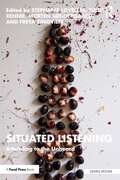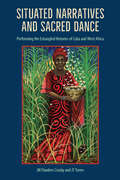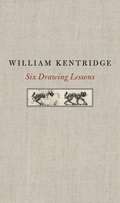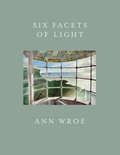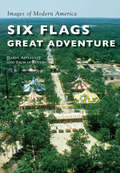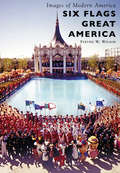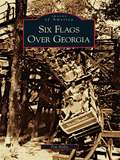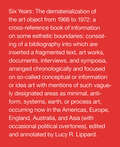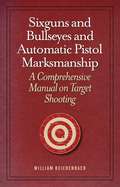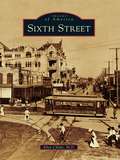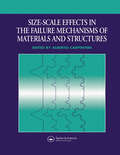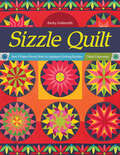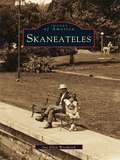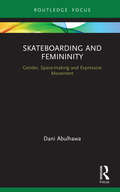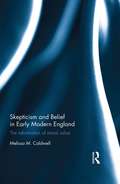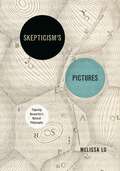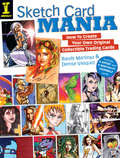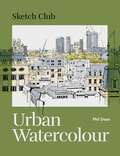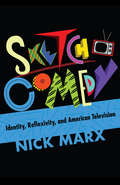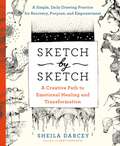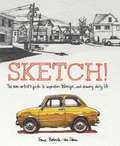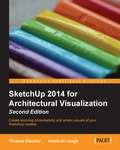- Table View
- List View
Situated Listening: Attending to the Unheard (Sound Design)
by Morten Søndergaard Stephanie Loveless Tullis Rennie Freya ZinovieffGrounded in a conviction that how we listen matters deeply in the context of ongoing social, political, and ecological crises, Situated Listening: Attending to the Unheard sets forth a collection of methodologies and creative proposals for listening, advancing the framework of situated listening as both a theoretical concept and a methodological practice that investigates relationships between the listening body and the politics of place, space, and culture.Drawing from an array of scholarship that engages sound studies broadly, this 15-chapter book is written entirely collaboratively and from a multidisciplinary perspective. Each section includes scores for situated listening, which take the form of diagrams, instructions, exercises, images, and meditations. The scores offer alternate modes of sharing the central ideas of the associated chapters, inviting the reader to shift from theory into practice. This book contributes to decolonial, feminist, anti-racist, and anti-capitalist scholarship in the field of sound studies, by centering listening as a relational practice.This book brings together a roster of accomplished, international contributors, making it essential supplementary reading for advanced undergraduates and researchers in sound studies. It will be of interest to faculty and students in the fields of Sound Studies, Music, Feminist Science and Technology Studies, Urban Design, and Sound Art.
Situated Narratives and Sacred Dance: Performing the Entangled Histories of Cuba and West Africa
by JT Torres Jill Flanders CrosbyUsing storytelling and performance to explore shared religious expression across continentsThrough a revolutionary ethnographic approach that foregrounds storytelling and performance as alternative means of knowledge, Situated Narratives and Sacred Dance explores shared ritual traditions between the Anlo-Ewe people of West Africa and their descendants, the Arará of Cuba, who were brought to the island in the transatlantic slave trade.The volume draws on two decades of research in four communities: Dzodze, Ghana; Adjodogou, Togo; and Perico and Agramonte, Cuba. In the ceremonies, oral narratives, and daily lives of individuals at each fieldsite, the authors not only identify shared attributes in religious expression across continents, but also reveal lasting emotional, spiritual, and personal impacts in the communities whose ancestors were ripped from their homeland and enslaved. The authors layer historiographic data, interviews, and fieldnotes with artistic modes such as true fiction, memoir, and choreographed narrative, challenging the conventional nature of scholarship with insights gained from sensorial experience.Including reflections on the making of an art installation based on this research project, the volume challenges readers to imagine the potential of approaching fieldwork as artists. The authors argue that creative methods can convey truths deeper than facts, pointing to new possibilities for collaboration between scientists and artists with relevance to any discipline.Publication of the paperback edition made possible by a Sustaining the Humanities through the American Rescue Plan grant from the National Endowment for the Humanities.
Six Drawing Lessons
by William KentridgeOver the last three decades, the visual artist William Kentridge has garnered international acclaim for his work across media including drawing, film, sculpture, printmaking, and theater. Rendered in stark contrasts of black and white, his images reflect his native South Africa and, like endlessly suggestive shadows, point to something more elemental as well. Based on the 2012 Charles Eliot Norton Lectures, Six Drawing Lessons is the most comprehensive collection available of Kentridge’s thoughts on art, art-making, and the studio. <p><p> Art, Kentridge says, is its own form of knowledge. It does not simply supplement the real world, and it cannot be purely understood in the rational terms of traditional academic disciplines. The studio is the crucial location for the creation of meaning: the place where linear thinking is abandoned and the material processes of the eye, the hand, the charcoal and paper become themselves the guides of creativity. Drawing has the potential to educate us about the most complex issues of our time. This is the real meaning of “drawing lessons.” <p> Incorporating elements of graphic design and ranging freely from discussions of Plato’s cave to the Enlightenment’s role in colonial oppression to the depiction of animals in art, Six Drawing Lessons is an illustration in print of its own thesis of how art creates knowledge. Foregrounding the very processes by which we see, Kentridge makes us more aware of the mechanisms―and deceptions―through which we construct meaning in the world.
Six Facets Of Light
by Ann Wroe'She's a genius, I believe, because she lights up every subject she touches.' Hilary Mantel A Spectator Book of the YearGoethe claimed to know what light was. Galileo and Einstein both confessed they didn't. On the essential nature of light, and how it operates, the scientific jury is still out. There is still time, therefore, to listen to painters and poets on the subject. They, after all, spend their lives pursuing light and trying to tie it down.Six Facets of Light is a series of meditations on this most elusive and alluring feature of human life. Set mostly on the Downs and coastline of East Sussex, the most luminous part of England, it interweaves a walker's experiences of light in Nature with the observations, jottings and thoughts of a dozen writers and painters - and some scientists - who have wrestled to define and understand light. From Hopkins to Turner, Coleridge to Whitman, Fra Angelico to Newton, Ravilious to Dante, the mystery of light is teased out and pondered on. Some of the results are surprising.By using mostly notebooks and sketchbooks, this book becomes a portrait of the transitoriness, randomness, swiftness, frustrations and quicksilver beauty that are the essence of light. It is a work to be enjoyed, pondered over, engaged with, provoked by; to be packed in the rucksack of every walker heading for the sea or the hills, or to be opened to bring that outside radiance within four dark town walls.Lifescapes by Ann Wroe is coming in August 2023.
Six Flags Great Adventure (Images of Modern America)
by Thomas Benton Harry ApplegateBuilt in 1974, Great Adventure was the larger-than-life dream of a larger-than-life personality, Warner LeRoy. The consummate showman, LeRoy had visions of a fantasy world of rides, shows, and animals in a beautiful and unspoiled woodland setting. In 1977, Great Adventure became a member of the Six Flags family of theme parks and has continued to grow ever since, with bigger and better attractions added each season. Six Flags Great Adventure revisits some of the park's past attractions, like the Garden of Marvels, Big Balloon, and Super Teepee, and illustrates the park's evolution into a state-of-the-art theme park enjoyed by a new generation of guests.
Six Flags Great America (Images of Modern America)
by Steven W. WilsonMarriott’s Great America first opened in Gurnee, Illinois, on May 29, 1976. Located midway between Chicago and Milwaukee, it was the second of two Marriott Corporation theme parks. Great America was created to be a place where families could have fun together while gaining an appreciation for United States history. The park’s five authentically themed areas based on America’s past included the best in family and thrill rides, restaurants, specialty shops, artisans, and games. First-rate live entertainment included Broadway-style musicals, bands, parades, a circus, and the Warner Bros. characters featuring BUGS BUNNY. In 1984, the park became Six Flags Great America when it joined the Six Flags family of theme parks. Since then, the park has continued to innovate and expand. Today, including its 20-acre Hurricane Harbor water park, Six Flags Great America is one of the country’s finest theme parks. Since 1976, the park has entertained more than 100 million guests.
Six Flags Over Georgia
by Tim HollisWhen Six Flags Over Georgia opened in June 1967, it became the first theme park in the Southeast. Although the park is best known today for its high-speed roller coasters, this book recaptures its earlier years when it was devoted to the various periods of Georgia's history. Six Flags Over Georgia revisits such classic rides and attractions as the Log Jamboree, Tales of the Okefenokee, Jean Ribaut'sAdventure, the Krofft Puppet Theater, the Happy Motoring Freeway, and many others. It also explores how the park's focus changed and expanded over the decades and takes a look at some of its classic advertising and souvenirs.
Six Paintings from Papunya: A Conversation
by Terry Smith Fred R. MyersIn the early 1970s at Papunya, a remote settlement in the Central Australian desert, a group of Indigenous artists decided to communicate the sacred power of their traditional knowledge to the wider worlds beyond their own. Their exceptional, innovative efforts led to an outburst of creative energy across the continent that gave rise to the contemporary Aboriginal art movement that continues to this day. In their new book, anthropologist Fred Myers and art critic Terry Smith discuss six Papunya paintings featured in a 2022 exhibition in New York. They draw on several discourses that have developed around First Nations art—notably anthropology, art history, and curating as practiced by Indigenous and non-Indigenous interpreters. Their focus on six key paintings enables unusually close and intense insight into the works’ content and extraordinary innovation. Six Paintings from Papunya also includes a reflection by Indigenous curator and scholar Stephen Gilchrist, who considers the nature and significance of this rare transcultural conversation.
Six Years: The Dematerialization of the Art Object from 1966 to 1972
by Lucy R. LippardIn Six Years Lucy R. Lippard documents the chaotic network of ideas that has been labeled conceptual art. The book is arranged as an annotated chronology into which is woven a rich collection of original documents—including texts by and taped discussions among and with the artists involved and by Lippard, who has also provided a new preface for this edition. The result is a book with the character of a lively contemporary forum that offers an invaluable record of the thinking of the artists—a historical survey and essential reference book for the period.
Sixguns and Bullseyes and Automatic Pistol Marksmanship: A Comprehensive Manual on Target Shooting
by William ReichenbachWhether you're a target shooting enthusiast, an experienced shooter, or someone who has never held a gun, Sixguns and Bullseyes and Automatic Pistol Marksmanship will help you explore different types of handguns, fundamental shooting skills, and expert tips to gain marksmanship precision.This edition combines two classic shooting manuals from the 1930s in one volume for modern audiences. Author and gun enthusiast William Reichenbach’s conversational, down-to-earth writing style makes this primer very approachable to all types of readers and shooters. He describes his seven key points—hold, stance, relaxation, moving the gun into position, sighting, squeeze, and breathing—as a basis to target shooting, as well as other topics, including:Ascent to the OlympTime and Rapid FireTrimming Your GunAmmunition WrinklesThe Ideal AutomaticThe “Draw”Preparing for the FrayHomo Sapiens and Other GameComplete with diagrams of important steps and stances as well as illustrations of classic revolvers and automatic pistols, this practical, easy-to-read, and surprisingly timely book will certainly guide interested shooters to that "elusive ten"!
Sixth Street
by Allen ChildsNow listed in the National Register of Historic Places, Sixth Street began more than 170 years ago as the only level pathway into the town of Austin from the east. Originally called Pecan Street, throughout its history the street was also a level playing field for merchants and minorities, for moneyed dynasties and little mom-and-pop places. When Austin was a segregated society, Sixth Street was a standout exception where people of all races lived and worked. By 1871, the arrival of the railroad kindled the explosive development of Pecan Street into Austin's first mercantile center. It was home to Austin's first hotel, Bullock's at Congress Avenue and Pecan Street; the first fight with the government of the new Republic of Texas; and the first brothel. In the 1970s, the commercial district suffered some deterioration. Then, as it has done before, Sixth Street was reborn, this time as the Sixth Street Historic Entertainment District. Loved by Austin residents and visitors alike, Sixth Street is Texas's most famous thoroughfare.
Size-Scale Effects in the Failure Mechanisms of Materials and Structures
by Alberto CarpinteriInvited international contributions to this exciting new research field are included in this volume. It contains the specially selected papers from 45 key specialists given at the Symposium held under the auspices of the prestigious International Union of Theoretical and Applied Mechanics at Turin in October 1994.
Sizzle Quilt
by Becky GoldsmithPut the Sizzle back into your quilting life! Make striking quilts designed by Becky Goldsmith that use the colors you love. Select one of two gorgeous colorways - warm (reds, oranges, and yellows) or cool (blues and greens) and begin your perfect paper-pieced quilt. Sew each quilt to make 9 paper-pieced 16-point stars with an appliqué border to create a modern, fun look guaranteed to brighten any room. Comes with multiple techniques that make this an invaluable learning tool, as well! Create stunning and precise stars with perfect corners using paper piecing From best-selling author and designer Becky Goldsmith, one half of the longtime design duo Piece O’ Cake Designs Bold and modern look made easy with simple construction instructions
Skaneateles
by Sue Ellen WoodcockIt is known as one of the most beautiful and cleanest lakes around, and for years Skaneateles Lake and the town of Skaneateles have served as the eastern gateway to the Finger Lakes, drawing visitors from all over the world. The beauty of the lake is enhanced by the well-kept village and town, which line its shores. Many of the early homes and buildings have been well maintained and are recognizable today. From the mid-1800s to the 1970s, the town changed little from when it was first settled in 1794.With sailboats and steamships, old views of the village and of school days of yore, Skaneateles recalls the people, places, and events that made a difference. Included are people such as John D. Barrow and Clarence Austin, places such as the Glen Haven Water Cure and the Packwood House, and events such as Bobby Kennedy's visit and Microd racing. Skaneateles also recalls the City of Syracuse and the town's great history of steamships, sailing and boating, and early industries.
Skateboarding and Femininity: Gender, Space-making and Expressive Movement (Routledge Advances in Theatre & Performance Studies)
by Dani AbulhawaSkateboarding and Femininity explores and highlights the value of femininity both within skateboarding and wider culture. This book examines skateboarding’s relationship to gender politics through a consideration of the personal politics connected to individual skateboarders, the social-spatial arenas in which skateboarding takes place, and by understanding the performance of tricks and symbolic movements as part of gender-based power dynamics. Dani Abulhawa anaylses the discursive frameworks connected to skateboarding philanthropic projects and how these operate through gendered tropes. Through the author’s work with skateboarding charity SkatePal, this book offers an alternative way of recognising the value of skateboarding philanthropy projects, proposing a move toward a more open and explorative somatic practice perspective.
Skepticism and Belief in Early Modern England: The Reformation of Moral Value
by Melissa M. CaldwellThe central thesis of this book is that skepticism was instrumental to the defense of orthodox religion and the development of the identity of the Church of England. Examining the presence of skepticism in non-fiction prose literature at four transitional moments in English Protestant history during which orthodoxy was challenged and revised, Melissa Caldwell argues that a skeptical mode of thinking is embedded in the literary and rhetorical choices made by English writers who straddle the project of reform and the maintenance of orthodoxy after the Reformation in England. Far from being a radical belief simply indicative of an emerging secularism, she demonstrates the varied and complex appropriations of skeptical thought in early modern England. By examining a selection of various kinds of literature-including religious polemic, dialogue, pamphlets, sermons, and treatises-produced at key moments in early modern England’s religious history, Caldwell shows how the writers under consideration capitalized on the unscripted moral space that emerged in the wake of the Reformation. The result was a new kind of discourse--and a new form of orthodoxy--that sought both to exploit and to contain the skepticism unearthed by the Reformation.
Skepticism’s Pictures: Figuring Descartes’s Natural Philosophy
by Melissa LoIn seventeenth-century northern Europe, as the Aristotelian foundations of scientia were rocked by observation, experiment, confessional strife, and political pressure, natural philosophers came to rely on the printed image to fortify their epistemologies—and none more so than René Descartes. In Skepticism’s Pictures, historian of science Melissa Lo chronicles the visual idioms that made, sustained, revised, and resisted Descartes’s new philosophy.Drawing on moon maps, political cartoons, student notebooks, treatises on practical mathematics, and other sources, Lo argues that Descartes transformed natural philosophy with the introduction of a new graphic language that inspired a wide range of pictorial responses shaped by religious affiliation, political commitment, and cultural convention. She begins by historicizing the graphic vocabularies of Descartes’s Essais and Principia philosophiae and goes on to analyze the religious and civic volatility of Descartes’s thought, which compelled defenders (such as Jacques Rohault and Wolferd Senguerd) to reconfigure his pictures according to their local visual cultures—and stimulated enemies (such as Gabriel Daniel) to unravel Descartes’s visual logic with devastating irony. In the epilogue, Lo explains why nineteenth-century French philosophers divorced Descartes’s thought from his pictures, creating a modern image of reason and a version of philosophy absent visuality.Engaging and accessible, Skepticism’s Pictures presents an exciting new approach to Descartes and the visual reception of seventeenth-century physics. It will appeal to historians of early modern European science, philosophy, art, and culture and to art historians interested in histories that give images their argumentative power.
Sketch Card Mania: How To Create Your Own Original Collectible Trading Cards
by Randy Martinez Denise VasquezIn this age of digital everything, presenting someone with an original, hand-drawn piece of art makes a big impression. So it's no wonder sketch cards (trading cards featuring one-of-a-kind artwork) are such a sensation. Packed with cool examples from various artists, Sketch Card Mania shows you how to create your own personal and professional-looking cards with guidance from long-time veteran of the trading card industry Randy Martinez.Basic technique instruction for sketching in pencil, colored pencil, pen and ink, colored markers, acrylic, watercolor and mixed mediaThe mechanics of designing and constructing sketch cards, from what to include on the back to printing, cutting and mounting them just right20 step-by-step demonstrations featuring a range of styles and subjects - heroes, villains, athletes, aliens, wizards, elf warriors and moreExpert tips for connecting with other artists, promoting yourself and sharing your work onlinePlus awesome inside tips on breaking into the business from five industry professionalsWhether your goal is to generate fans, get commissions or just have fun, this book will show you how to make stand-out cards that really say something about you as an artist.
Sketch Club: Urban Watercolour
by Phil Dean***Take your urban sketching skills to the next level with watercolour. Bestselling author and artist Phil Dean (@shoreditchsketcher) provides a step-by-step guide to creating beautiful urban artworks. Get started with the very basics of depicting cityscapes with a pencil or pen, including tips on perspective, measuring, and mark-making. Then move straight on to the core watercolour techniques you will need to introduce stunning colour and tone to your sketches.With 20 easy-to-follow exercises on everything from negative space to line & wash, Sketch Club: Urban Watercolour is your go-to guide to elevating your urban art. Chapters include:- Loosening Up- Urban Drawing 101- Getting Started with Watercolour- Taking Your Watercolour Further- Finishing Touches
Sketch Club: Urban Watercolour
by Phil Dean***Take your urban sketching skills to the next level with watercolour. Bestselling author and artist Phil Dean (@shoreditchsketcher) provides a step-by-step guide to creating beautiful urban artworks. Get started with the very basics of depicting cityscapes with a pencil or pen, including tips on perspective, measuring, and mark-making. Then move straight on to the core watercolour techniques you will need to introduce stunning colour and tone to your sketches.With 20 easy-to-follow exercises on everything from negative space to line & wash, Sketch Club: Urban Watercolour is your go-to guide to elevating your urban art. Chapters include:- Loosening Up- Urban Drawing 101- Getting Started with Watercolour- Taking Your Watercolour Further- Finishing Touches
Sketch Comedy: Identity, Reflexivity, and American Television
by Nick MarxA history of sketch comedy on American television and analysis of what it says about American culture and society.In Sketch Comedy: Identity, Reflexivity, and American Television, Nick Marx examines some of the genre’s most memorable?and controversial?moments from the early days of television to the contemporary line-up. Through explorations of sketches from well-known shows such as Saturday Night Live, The State, Inside Amy Schumer, Key & Peele, and more, Marx argues that the genre has served as a battleground for the struggle between comedians who are pushing the limits of what is possible on television and network executives who are more mindful of the financial bottom line. Whether creating new catchphrases or transgressing cultural taboos, sketch comedies give voice to marginalized performers and audiences, providing comedians and viewers opportunities to test their own ideas about their place in society, while simultaneously echoing mainstream cultural trends. The result, Marx suggests, is a hilarious and flexible form of identity play unlike anything else in American popular culture and media.“An excellent study of a long-neglected area in television/media studies and is part of a larger turn toward the centrality of comedy in post-war U.S. culture.” —Jeffrey Sconce, Northwestern University“A stalwart of television . . . sketch comedy finally gets the in-depth critical attention it deserves . . . Marx shows how sketch comedy has fit (and been constrained by) TV’s industrial contexts, from live variety shows in its earliest days to movement across media in the era of multiple platforms. These case studies not only chart sketch comedy’s past, they provide the theoretical and analytical tools to consider its future.” —Ethan Thompson, Texas A&M University Corpus Christi
Sketch Comedy: Identity, Reflexivity, and American Television
by Nick MarxA history of sketch comedy on American television and analysis of what it says about American culture and society.In Sketch Comedy: Identity, Reflexivity, and American Television, Nick Marx examines some of the genre’s most memorable?and controversial?moments from the early days of television to the contemporary line-up. Through explorations of sketches from well-known shows such as Saturday Night Live, The State, Inside Amy Schumer, Key & Peele, and more, Marx argues that the genre has served as a battleground for the struggle between comedians who are pushing the limits of what is possible on television and network executives who are more mindful of the financial bottom line. Whether creating new catchphrases or transgressing cultural taboos, sketch comedies give voice to marginalized performers and audiences, providing comedians and viewers opportunities to test their own ideas about their place in society, while simultaneously echoing mainstream cultural trends. The result, Marx suggests, is a hilarious and flexible form of identity play unlike anything else in American popular culture and media.“An excellent study of a long-neglected area in television/media studies and is part of a larger turn toward the centrality of comedy in post-war U.S. culture.” —Jeffrey Sconce, Northwestern University“A stalwart of television . . . sketch comedy finally gets the in-depth critical attention it deserves . . . Marx shows how sketch comedy has fit (and been constrained by) TV’s industrial contexts, from live variety shows in its earliest days to movement across media in the era of multiple platforms. These case studies not only chart sketch comedy’s past, they provide the theoretical and analytical tools to consider its future.” —Ethan Thompson, Texas A&M University Corpus Christi
Sketch by Sketch: A Creative Path to Emotional Healing and Transformation (A SketchPoetic Book)
by Sheila DarceyTransform your life, process your emotions, and find joy in Sheila Darcey's Sketch by SketchDuring a difficult time in her life, author Sheila Darcey found that the act of sketching and freestyle drawing—of giving a physical form to her thoughts, emotions and ideas—was an impactful way to process what she was feeling. One simple sketch became a daily practice and developed into a meditative and therapeutic tool that Sheila has taught and shared with thousands of people. Sketch by Sketch will help you create a daily sketching practice that shifts you from negative thinking and spiraling emotions into the realm of possibility. By using art to connect your left brain with your right brain, Sketch by Sketch will unlock your basic human need to create, express, and feel—regardless of whether or not you think of yourself as an artist. In Sketch by Sketch, you’ll find over 40 sketching prompts on a variety of topics from hope to stillness that will help you connect with your emotions, practice mindfulness, and negotiate change. With each drawing you'll find you are able to process your experiences in a powerful new way. Step by step, sketch by sketch, you'll find peace, creativity, and healing on the page.
Sketch!
by France Belleville-Van StoneAn inspirational manual for integrating sketching into daily life for artists and non-artists alike. Urban sketching--the process of sketching on the go as a regular practice--is a hot trend in the drawing world. In this aspirational guide, French artist France Belleville-Van Stone offers motivation to move beyond the comfort zone, as well as instruction on turning rough sketches into finished work. By sharing her own creative process, which includes sketching by hand and digitally, Belleville-Van Stone emboldens readers to craft a method of their own and devote more time to art, even if it's just 10 minutes a day. Sketch will inspire artists both established and aspiring to rethink their daily practice, sketch for the pure joy of it, and document their lives and the world around them.From the Trade Paperback edition.
SketchUp 2014 for Architectural Visualization Second Edition
by Robin De Jongh Thomas BleicherBeginning with a quick start tutorial which will get you up and running with SketchUp 2014 quickly, you will move on to learning the key skills you will need to wow your clients with stunning visualizations through a series practical steps, tips and tricks. If you are a SketchUp user, from an amateur right through to an architectural technician, professional architect, or designer, this is the book for you. This book is also suitable as a companion to any architectural design or multimedia course, and is accessible to anyone who has learned the basics of SketchUp.
